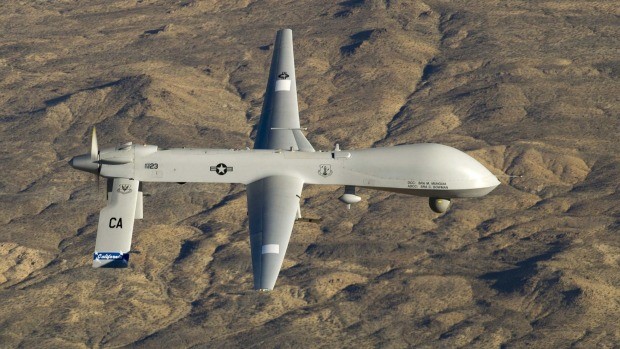Search
Democracy Links
Member's Off-site Blogs
"NoForn" .....

Drone strikes and other "targeted killings" of terrorist and insurgent leaders favoured by the US and supported by Australia can strengthen extremist groups and be counterproductive, according to a secret CIA report published by WikiLeaks.
According to a leaked document by the CIA's Directorate of Intelligence, "high value targeting" (HVT) involving air strikes and special forces operations against insurgent leaders can be effective, but can also have negative effects including increasing violence and greater popular support for extremist groups.
The leaked document is classified secret and "NoForn" (meaning not to be distributed to non-US nationals) and reviews attacks by the United States and other countries engaged in counter-insurgency operations over the past 50 years.
The CIA assessment is the first leaked secret intelligence document published by WikiLeaks since 2011. Led by Australian publisher Julian Assange, the anti-secrecy group says the CIA assessment is the first in what will be a new series of leaked documents relating to the US agency.
The 2009 CIA study lends support to critics of US drone strikes in Afghanistan, Iraq, Pakistan, Somalia and Yemen by warning that such operations "may increase support for the insurgents, particularly if these strikes enhance insurgent leaders' lore, if non-combatants are killed in the attacks, if legitimate or semi-legitimate politicians aligned with the insurgents are targeted, or if the government is already seen as overly repressive or violent".
Drone strikes have been a key element of the Obama administration's attacks on Islamic extremist terrorist and insurgent groups in the Middle East and south Asia. Australia has directly supported these strikes through the electronic espionage operations of the US-Australian Joint Defence Facility at Pine Gap near Alice Springs in the Northern Territory.
The CIA study observes that the US-led coalition in Afghanistan made "a sustained effort since 2001 to target Taliban leaders", but "Afghan government corruption and lack of unity, insufficient strength of Afghan and NATO security forces, and the country's endemic lawlessness have constrained the effectiveness of these counter-insurgency elements".
"Senior Taliban leaders' use of sanctuary in Pakistan has also complicated the HVT effort," the CIA says. "Moreover, the Taliban has a high overall ability to replace lost leaders, a centralised but flexible command and control overlaid with egalitarian Pashtun structures, and good succession planning and bench strength, especially at the middle levels."
The CIA study also reports mixed results for such tactics in Iraq, noting that al-Qaeda in Iraq "initially lost several iterations of its senior leadership and numerous local emirs, but these losses initially did little to slow AQI's momentum".
Similarly, the CIA observes that Israel's "targeted-killings campaign" against Hamas and Hezbollah was of limited effectiveness owing to "decentralised command structures, compartmented leadership, strong succession planning, and deep ties to their communities, making the[se] groups highly resilient to leadership losses".
The CIA review does suggest that targeted killings can be useful when they are part of a broader counter-insurgency strategy that employs other military and non-military counter-insurgency instruments.
Well before his death in a 2011 US special forces raid, al-Qaeda leader Osama bin Laden's efforts to avoid detection, including "reliance on low-technology communications, his reluctance to meet with subordinates, and his contentment with leading from a sequestered distance via infrequent contact … affected his ability to command his organisation".
Other strategic objectives of targeted killings include "fragmenting or splitting the insurgent group".
In the case of Northern Ireland, the CIA suggests that British tactics deliberately strengthened the position of moderates within the Irish Republican Army, notably Gerry Adams and Martin McGuinness, who eventually engaged in negotiations that lead to a non-violent settlement of conflict.
"The British saw an interest in protecting [Adams] and members of his faction … Acting on intelligence gained through penetrations, the British eliminated some radical IRA members who could have obstructed the peace process or challenged the Adams faction for leadership of the group."
However, the CIA also warns that targeting insurgent leaders "may, by eroding the rules of the game between the government and insurgents, escalate the level of violence in a conflict, which may or may not be in a government's interest."
"Israeli HVT efforts from 2000 to 2002 strengthened solidarity between terrorist groups and bolstered popular support for hard-line militant leaders, according to US Embassy officials in Jerusalem and clandestine reporting," the study says.
US drone strikes: reported deaths and injuries
Pakistan 2004-2014
US drone strikes: 405
Total killed: 2,400-3,888
Civilians killed: 416-959
Children killed: 168-204
Injured: 1,133-1,706
Yemen 2002-2014
US drone strikes: 72-84
Total killed: 371-541
Civilians killed: 64-83
Children killed: 7
Injured: 81-199
Somalia 2007-2014
US drone strikes: 6-9
Total killed: 16-30
Civilians killed: 0-1
Children killed: 0
Injured: 2-3
Statistics compiled by the Bureau of Investigative Journalism.
The CIA study can be found at wikileaks.org.
Drone strikes counterproductive, says secret CIA report
- By John Richardson at 19 Dec 2014 - 11:51pm
- John Richardson's blog
- Login or register to post comments
Recent comments
2 hours 20 min ago
2 hours 27 min ago
4 hours 15 min ago
4 hours 21 min ago
4 hours 25 min ago
6 hours 32 min ago
8 hours 6 min ago
1 day 1 hour ago
1 day 1 hour ago
1 day 1 hour ago